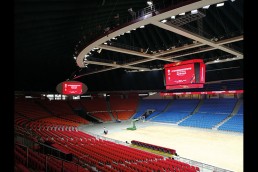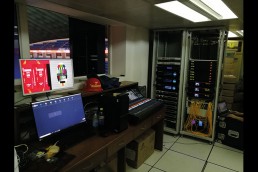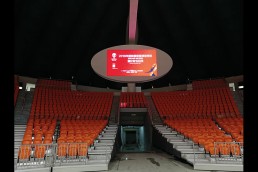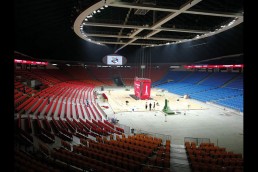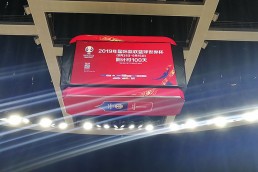This website uses cookies so that we can provide you with the best user experience possible. Cookie information is stored in your browser and performs functions such as recognising you when you return to our website and helping our team to understand which sections of the website you find most interesting and useful.
Guangzhou Gymnasium
ProjectGuangzhou GymnasiumLocationGuangzhou, ChinaManufacturers RGBlinkInstallerMR LEDSubmitted by RGBlink
Guangzhou Gymnasium indoor stadium has impressively enhanced its facilities with a newly installed suspended LED display. Comprising a multi-sided arena display, this display, along with additional LED display screens set around the arena, were supplied by Shenzhen-based, MR LED. With the multipurpose venue used extensively for indoor sports, including the very popular basketball league, the displays are a welcome addition.
The central arena display – a series of 5mm pitch displays hanging centrally over the courts – is made up of upper and lower continuous rings, each at 4,352 x 1,280 pixels and 4,032 x 1,280 pixels respectively, forming ticker style messaging displays. Between these two rings are back-to-back displays – two 40 sq metre central displays at 1,888 x 800 pixels capped at either side with a pair of poster/banner displays at 1,024 x 800 pixels each. The complete assembly can be raised and lowered to event requirements, making maintenance a straightforward exercise.
At either end of the stadium, two further 40 sq metre LED display screens have been installed, while perimeter signage, also in LED, has been installed on the mezzanine edge completing the coverage.
To process and deliver video to this wide range of displays just a single RGBlink X7 universal video processor ihas been installed, allowing multiple displays to be configured and used as a single display system. The video and media sources, including PC based scoring and media display applications, are connected directly to the X7, which converts and scales video to each individual display requirements via presets configured directly on the processor.
The two ring displays and the perimeter displays, all of which are long narrow strips, are nonetheless utilised for a full range of graphical displays. The X7 splices across multiple outputs and maps the video sources across these. With the configurations stored as presets, X7 allows seamlessly pixel-to-pixel spliced video to be delivered to these displays, reducing the complexity and need for specialist input media.
Similarly, camera feeds are connected directly to X7 as needed from the in-house broadcast infrastructure. These camera sources – again via presets – are able to display as windows/PIPs or brought to full screen on individual displays, on demand, in exactly the formats required for the particular resolution needed.
With all sources needing to be connected at a single processor, not only was the installation process simplified, but the system also provides for an optimised user experience for the operators as well as enhancing the overall video performance.
“RGBlink has a strong reputation in the market,” said Mr Wang of MR LED. “We were really pleased to use X7 on this important project.” The project support from the RGBlink team has been impressive, helping to bring together all the video displays seamlessly, so we have really been able deliver a complete solution for the stadium.”
Configuration and control of the X7 universal video processor is undertaken remotely from the RGBlink XPOSE software platform. While all processing and settings are maintained on the X7 hardware, XPOSE offers a modern and intuitive drag-and-drop style GUI from which operators have a clear view of both the current live output operations, as well as presets. Sources streamed from the processor to XPOSE, allow the operators to have virtual views of each preset on demand directly inside the software. A PC workstation with XPOSE is installed in the control room overlooking the court installation at Guangzhou Gymnasium installation, along with preview monitoring directly from the X7.
